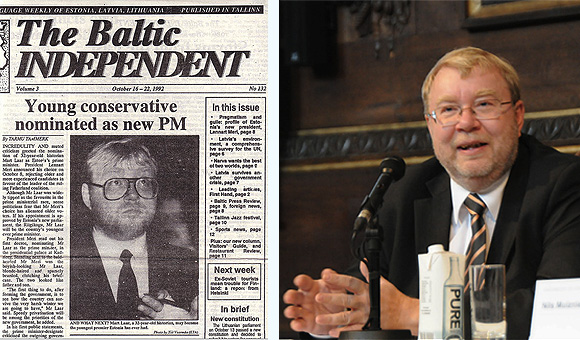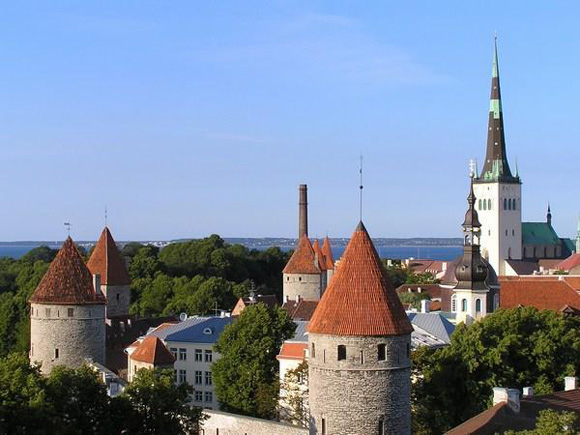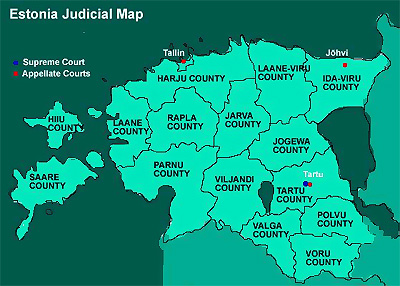In the two decades since restoring its independence, Estonia has proved to be a very successful reformer. The Little Country That Could got its epithet from Mart Laar, the former Prime Minister and current the Minister of Defense in Estonia. Laar is considered to be the father of the economic reforms that served as the catalysts to the country’s rapid development over the course of the past 20 years. Laar's reforms were acknowledged as the most successful and comprehensive in the region and are used as a model for other countries with transitional economies.

Mart Laar in 2002 and in 2006
After gaining its independence, Estonia needed to deal with the consequences of almost 50 years of Soviet totalitarian rule while taking measures for the rapid and efficient integration into the European economic arena. Estonian reforms were aimed at lustration, the economy, and the law enforcement and judicial systems. The specifics of the Estonian economic reform of the transition period include hybrid privatization, the instatement of a flat income tax, and strict changes to the legislature associated with banking.
On January 1, 2011 Estonia, which had for a long time enjoyed the reputation of being the most radical market reformer in Europe1, adopted the euro and became the 17th member of the EU to give up its national currency. Estonia was also the first former Soviet republic to enter the euro zone, in addition to being the first country to leave the ruble zone in June of 1992. It started growing economically as early as 1994. In 1993, Estonia became a member of the Council of Europe; in 1999, it joined the WTO; and in 2004, became a member of NATO and EU. Estonia was the first of the former Soviet republics to introduce its national currency and make it convertible. Estonia's entering the euro zone became a symbol of the success of the market reforms that took place after its secession from the Soviet Union.
In 1992, the Estonian government, which consisted of young and talented academics, started the liberalization of prices for both national and international trade. This measure allowed the country to promptly overcome the deficit of goods and services that was typical of socialism and to transform Estonia into the country with the most free trade and the lowest level of corruption among all former Soviet republics. Before the transformation, Estonia, Latvia and Lithuania all had governments that changed every year. However, this fact had no impact on political stability in the region, since all the coalition governments had the same goal: the development of the market economy. These market reforms created the foundation for sustainable economic growth. Estonia became much more attractive from the viewpoint of foreign investors. The level of direct foreign investments went from $265 million in 1994 to $581 million in 1998. According to Forbes, Estonia ranks 16th out of 179 on the Heritage Foundation’s Index of Economic Freedom; 26th out of 178 on Transparency International’s Corruption Perceptions Index; and 17th out of 183 on the World Bank’s Ease of Doing Business Index.
The economic crisis of 2009 was a shock for Estonia. However, the government rejected the idea of depreciation and stayed on the track of budgetary conservatism. No considerable loans were made on the financial markets, and the government managed to take inflation under control and even to somewhat decrease the rate of inflation. When the necessary anti-crisis measures were taken, Estonia made the most radical reduction of public expenditures in the region. In 2010, the financial state of Estonia was deemed compatible with the Maastricht criteria (the state debt was 6% of the GDP, the budget deficit didn't exceed 3% of the GDP, and the annual inflation rate didn't exceed 3%). Although the political choices of the Estonian government and the rejection of the idea of depreciation made the consequences of the world financial crisis more severe for the citizens, those measures were the starting point of Estonia’s entering into the euro zone and ultimately becoming integrated into Western Europe.
Judicial reform in Estonia was an important part of the process of restoration of democracy and independence. The goal of the reforms was the reconstruction of a modern and efficient judiciary based on the Western European model and in compliance with fundamental democratic principles. In the course of judicial reform, the Estonians used the experience gathered through the centuries Estonia spent under German and Swedish rule. These affected the Estonian law enforcement and justice systems, which bear both the traces of ancient national law and the impact of Roman law. In the 18th century, after the end of the Great Northern War and the surrender of Sweden, the territory of today's Estonia became a part of the Russia Empire, and remained so until 1917. On November 28, 1917, Estonia’s Provisional National Council proclaimed itself the supreme body of state power in Estonia, but due to the German invasion and the Russian Revolution, the process of shaping the Estonian national judiciary did not begin until the end of 1918. The National Court was set up in 1919 and became the supreme body of judicial power in Estonia. Shortly thereafter, the system of administrative justice was introduced. The Act on Courts was adopted in 1938 and symbolized the completion of the formation of the national judiciary. At that time, Estonia already had its own criminal and civil codes and the appropriate procedural legislation.
The forced incorporation of Estonia into the Soviet Union translated into the loss of sovereignty and the dissolution of the national judiciary. The National Court was liquidated, the Court of Appeals and regional courts were replaced by the Supreme Court and people’s courts. District courts were retained as first and second instance courts. All the legislation governing the status of judges and court proceedings was annulled, as were the civil and the criminal codes. In their place, the Russian SSR codes and other legal acts were put into effect in Estonia beginning on January 1, 1941. All judges and prosecutors were dismissed from office and subsequently (unless they had been able to flee abroad) subjected to persecution. Twenty years’ work on establishing the national judiciary was thus demolished in the span of two months.

Historical center of Tallinn, the capital and largest city of Estonia
After initiating the process of restoring independence in Estonia, a number of urgent measures were taken in order to nullify the Soviet legacy, especially in the realm of the courts. On May 16, 1990, the Supreme Soviet of Estonia declared that the national judiciary should be set up in accordance with the wishes of the Estonian people and the recognized norms of international law. In 1991, a huge set of legislative acts was passed, which served as proof that the Estonian government was truly committed to improving the judiciary and connected institutions. In the table below, we can compare the dates when similar legislation was passed in Russia.
| Estonia | Russia |
| 1991 — «On Advocacy in Estonia» | 2002 — «On Advocacy in the Russian Federation» |
| 1991 — «On Courts» | 2011 — «On the Courts of General Jurisdiction» |
| 1991 — «On the Status of Judges» | 1992 — «On the Status of Judges in the Russian Federation» |
| 1991 — amendments to the law «On Police» | 2011 — «On Police» |
| 1992 — Criminal Code | 1996 — Criminal Code |
Unlike in Russia, where the official start of judicial reform came with the publication of the Concept of Judicial Reform in October of 1991, reform was never proclaimed in Estonia, but changes were made quickly.
The fundamentals of the Estonian court system are envisaged in Chapter 13 of the Constitution of 1992, in the Courts Act and the Status of Judges Act. The reconstituted Supreme Court held its first session on May 27, 1993 in Tartu. On October 1st of that year, the Soviet-era Supreme Court was abolished, and on December 15, 1993, a constitutional three-tier judiciary became operational. By the end of 1994, Estonia had 2 administrative law courts (in Tallinn and Tartu), 21 city and county courts, 3 circuit courts (in Tallinn, Tartu, and Jõhvi), among which a total of 166 judges were administering justice (32 sat in administrative law courts, 101 in city and county courts, 33 in district courts and 16 in the Supreme Court). By that time the Estonian judicial corps had undergone a 67% renewal. The average age for judges was less than 40.

Renewing the judicial corps was an essential measure to speed up the departure of the Soviet past, and Estonia wasn't the only formerly Communist country to take this approach. After the unification of Germany, the judges from the GDR were dismissed from office and replaced by the young judges from West Germany. Nothing of the kind was attempted in Russia.
The Estonian government quickly realized the importance of establishing a system for judges’ professional development. As early as 1995, the Estonian Law Center Foundation became very active in this realm, and in 2009, this function was transferred to the national Supreme Court. In Russia, this issue came up in the agenda three years later, and the newly created Russian Academy of Justice was put charge of the process. The RAJ was co-founded by the Supreme Court and the Highest Court of Arbitration of Russia and initially, it was nothing but an institution where judges simply seemed to replicate themselves in established images. This is in sharp contrast to Estonia, where for 14 years the system for raising judges’ qualifications was run by a civil society institution. In Russia, the potential of the civil society institution in this area was employed rarely and warily.
As part of the judicial reform process, all former judges who practiced law under Soviet rule and all other applicants were required to apply for the position of judge and to take a qualification exam. This practice could be very effective in Russia, where many judges still possess a Soviet mentality and demonstrate accusatory bias. Truth be told, such judges would never pass the qualification exams, where the main objective is to determine whether a former Soviet judge could practice law in a transformed political and economic landscape.
Article 3 of the Estonian law on the Status of a Judge envisaged that applicants must be persons of high moral character who can make good judges. All applicants are also required to have completed the University of Tartu Law Program, or have equivalent qualifications. Russian judges aren't required to possess high moral characters, although an exception was made for the justices of the Constitutional Court. Article 8 of the law «On the Constitutional Court of the Russian Federation» establishes the requirement of a good reputation for the members of the Constitutional Court. It seems that Russian lawmakers don’t think that judges need high moral character — it would just make their jobs harder.
The considerable achievements of Estonian judicial reform include the establishment of systems for constitutional justice and administrative justice. As for Russia, the draft law «On the Federal Administrative Courts in the Russian Federation» was passed on in the first reading on November 22, 2000. Since that time, the draft has remained in the State Duma. Random case assignment was introduced in the courts of the first and second instance (article 7.1 of the Estonian Law «On Courts»). The establishment of the position of the Chancellor of Justice (a governmental official similar to an Ombudsman), whose status and powers are envisaged in Chapter 12 of the Constitution of Estonia, was also a big achievement.
Along with the judicial reform in 1990s, Estonia also started reforming its law enforcement agencies, targeting the restoration of the Estonian police. These reforms actually started to take shape before Estonia re-gained its independence. This happened in three stages: reconstructing the police force, bringing the law enforcement agency system into compliance with EU requirements, and unifying all law enforcement agencies into a single organization. How the police force, an institution which actively interacts with the judiciary, was reformed in Estonia, Russia, and some other former Soviet republics deserves special attention, and my next column will be devoted to just such an analysis.
1 Mart Laar, Little Country That Could (London: Centre for Research into Post-Communist Economies, 2002).

